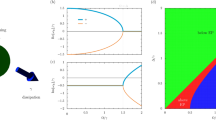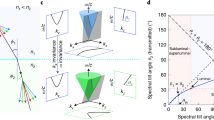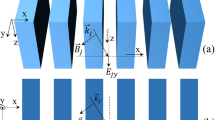Abstract
This contribution has two main purposes. First, using classical optics we show how to model two coupled quantum harmonic oscillators and two interacting quantized fields. Second, we present classical analogs of coupled harmonic oscillators that correspond to anisotropic quadratic graded indexed media in a rotated reference frame, and we use operator techniques, common to quantum mechanics, to solve the propagation of light through a particular type of graded indexed medium. Additionally, we show that the system presents phase transitions.
Similar content being viewed by others
Introduction
The existence of analogies between quantum and classical mechanics has been applied for many years, particularly in the generation of mathematical tools to provide solutions of optical problems and vice versa1,2,3,4,5,6,7,8,9,10,11. The reason is that the optical paraxial wave equation is mathematically equivalent to the stationary Schrödinger equation and, on the other hand, Helmholtz equation has a treatment similar to that of time-independent Schrödinger equation. Exploring analogies between different physical problems is useful, as it allows exporting insights from one context to the other.
Classical optics systems have been used to model quantum optical phenomena6. There has been also a proposal by Man’ko et al.12 to realize quantum computation by using quantum-like systems. Coherent random walks have been shown to occur in free propagation provided the initial wave function is tailored properly13. The modelling of time-dependent harmonic oscillators has been achieved in a graded indexed (GRIN) media14 allowing to show the splitting of modes in second order solutions of the Helmholtz equation15. The propagation of classical fields in a graded indexed medium with linear dependence has shown to produce and control Airy modes16.
On the other hand, much attention has been recently devoted to the study of phase transitions17,18 in the Rabi Model19,20. By means of the Holstein-Primakoff transformation21, it may be argued that the interaction of two quantized fields is similar to the Rabi interaction, when we approximate the spin-flip operators as creation and annihilation operators and the energy Pauli matrix as a harmonic oscillator, and thus the two interacting fields can show phase transitions.
Being aware of all of these correspondences, in this contribution we apply methods commonly used in quantum optics to solve a problem of classical optics. Although, we could use variable separation to solve the propagation of light in GRIN media, we believe it is of interest to use operator techniques, commonly used in quantum mechanics, as there may be cases in which the refraction index not only depends on x and y but also on the propagation distance z (see for instance Urzúa et al.22), and then the separation of variables is not possible.
In particular, we show in the next section that classical light propagation in an inhomogeneous medium models a coupled quantum harmonic oscillators or the interaction of two quantized fields. In the same section, we also show the conditions for a phase transition of the coupled system, in the sense that the set of parameters involved lead one of the oscillators go through harmonic to free particle and finally to a repulsive oscillator. In the Section Invariant modes, we show that it is possible to obtain invariant modes in the classical propagation of light in the specific inhomogeneous medium considered. In the Section titled Helmholtz equation, we briefly discuss the possibility of splitting a beam by taking into account the fact that, to second order in the Helmholtz equation, a kind of quantum Kerr medium is modelled. Finally, the last section is left for conclusions.
Paraxial Wave Equation for Inhomogeneous Media
There exist classical optical systems related to waveguiding of optical modes that may be described by the paraxial wave equation
where λ and k0 = 2πn0/λ are the wavelength and the wavenumber of the propagating mode, respectively, and n0 is the homogeneous refraction index. The function k2(x, y) describes the inhomogeneity of the medium responsible for the waveguiding of the optical field E. The inhomogeneity may be physical, in the sense that it is produced in the medium when fabricated; an example of such a medium is a graded index fiber. In particular, we will consider23
being kx, ky and g parameters that characterize the inhomogeneous medium. In ref.23, it was proposed a way, that could be easy to realize experimentally, of generating the inhomogeneity function k2(x, y) by the co-propagation of two modes in a Kerr nonlinear medium.
Equation (1), which is analogous in structure to the Schrödinger equation24, together with the inhomogeneity (2), has been solved for the special case of \(g\ll {k}_{x},{k}_{y}\) using the so-called rotating wave approximation23; here, we solve it for any set of parameters. We may rewrite Eq. (1) as
with
where the momentum operators have the usual definition on configuration space, \({\hat{p}}_{x}=-\,{\rm{i}}\frac{\partial }{\partial x}\) and \({\hat{p}}_{y}=-\,{\rm{i}}\frac{\partial }{\partial y}\). By considering the unitary operator
we make the transformation \(E={\hat{R}}_{\theta }^{\dagger } {\mathcal E} \), such that we obtain a Schrödinger-like equation for \( {\mathcal E} \) as
where
were obtained from the set of transformations
From Eq. (7c), we choose \(\theta =\frac{1}{2}\arctan (\frac{2g}{{k}_{y}-{k}_{x}})\) and we have
and then Equations (7) take the form
so that (6) is transformed into the equation of two uncoupled quantum harmonic oscillators
for which we know the formal solution.
We may see from Eq. (10a), that for some values of the parameters kx, ky and g of the inhomogeneity of the medium, the effective frequency of the oscillator, \({\tilde{k}}_{x}\), goes from positive to negative (see Fig. 1), therefore undergoing a phase transition17,18. It basically shows that the oscillator in the variable x goes from a harmonic oscillator to a repulsive harmonic oscillator, passing through a free particle25. In other words, if we define a critical value for g,
we have the following three cases:
If in Eq. (6), we write x and y in terms of annihilation and creation operators, we see that the so-called counter rotating terms have not been neglected (i.e., the rotating wave approximation was not performed). The presence of those terms is responsible for the phase transition in the propagation of light in the GRIN (Gradient-index) medium we are considering23.
A mechanical system equivalent to the light propagation analyzed above is given by two masses connected between them by springs and connected to physical or mathematical constrains (like a pair of walls) also by springs, as it is depicted in Fig. (2). The equations that rule this system are26
where q0, q1 are the positions of mass m0 and mass m1, respectively, and κ0, κ1, κ2 are the three spring constants. Introducing the Hamiltonian
in the Hamilton equations, performing some derivatives and some algebra, we get the system (14). So, (15) is indeed a Hamiltonian of the system illustrated in Fig. (2).
We can make now the connection between our model of light propagation with this mechanical system. If in Eq. (3) we make z → −t and
the two Hamiltonians, (4) and (15), are identified. We can go also in the other sense, from the mechanical system to the light propagation model, making t → −z and
Invariant Modes
It is easy to show that there exist invariant modes (without dependence on the propagation) for the inhomogeneity we are studying, provided that the parameter \({\tilde{k}}_{x}\) is positive, so that we keep ourselves in the regime of an harmonic oscillator. Consider a field at z = 0 given by
where ψnx(x) and ψny(y) are Hermite-Gauss functions; i.e., eigenfunctions of the harmonic oscillators given in (11). This allows us to write the initial transformed field (16) as \( {\mathcal E} (x,y,z\,=\,\mathrm{0)}\,=\,{\psi }_{{n}_{x}}(x){\psi }_{{n}_{y}}(y)\) and therefore write the solution of Eq. (11) as
that produces the propagated field
that is clearly an invariant mode with associated phases depending on the angular quantities \({\omega }_{x}=\sqrt{{\tilde{k}}_{x}}\) and \({\omega }_{y}=\sqrt{{\tilde{k}}_{y}}\), and in the independent energy levels nx and ny. The way the operator \({\hat{R}}_{\theta }\) acts on the Hermite-Gauss functions on (18) is detailed in the Appendices.
Some examples of the behavior of the propagated field E(x, y, z) in (18) are shown in Fig. 3.
Plot of the square modulus of (18) for different values of nx and ny. Upper left: nx = ny = 1, upper right: nx = ny = 2, lower left: nx = ny = 3, lower right: nx = ny = 4. For all the cases kx = 1.2, ky = 1.5 and g = 0.25. The propagation is invariant along the propagation axis, i.e., it does not depend on the propagation distance z, despite the selection of the energy levels.
It is convenient to stress that although the propagation is invariant, there are some values of the coefficients {kx, ky, g} for which there is a phase transition and therefore the parameter \({\tilde{k}}_{x}\) goes from positive (an usual harmonic oscillator) to negative (a repulsive harmonic oscillator). In the negative region, see Fig. 1, the Hermite-Gauss functions are not anymore eigenfunctions of the repulsive harmonic oscillator, therefore an invariant mode is not produced. As it was pointed out by Yuce27 and Muñoz28, the eigenfunctions of the repulsive harmonic oscillator are a combination of the eigenfunctions of the free particle due to the existence of a equivalence between the repulsive potential and the free evolution through a proper canonical transform. Since these eigenfunctions are a combination of plane waves and waves confined in a box or propagating to a potential barrier, the non invariance argument above when g > gc follows.
Helmholtz Equation
We consider now the complete Helmholtz equation
For the case we considered above, in the section titled Paraxial wave equation for inhomogeneous media, and doing the same transformation (5), we arrive to
that may be developed to second order in κ2 = k02 − kx − ky to obtain the approximation
where
This equation allows the splitting of fields29 as the square terms resemble nonlinear quantum optical interactions, namely a quantum Kerr medium30.
Conclusions
We have shown that we can model the interaction of two masses through springs, i.e. two coupled quantum harmonic oscillators and the interaction of two quantized fields in a graded index media. The solutions we have given to second order approximation of the Helmholtz equation show how a beam splitter may be achieved in such media. We have also studied that phase transitions occur in the propagation of light in this medium, by showing that one of the harmonic oscillators is inverted for certain values of the parameters involved.
Factorization of the operator R̂θ
In this appendix the unitary operator
is factorized.
We define the operators
The exponential of the operator \({\hat{K}}_{0}\) is nothing but a product of squeeze operators31,32,33,34,35. The above operators have the commutators
and thus generate a su(1, 1) algebra. We find the factorization
where f1, f2, f3 are given by
or, writing it explicitly in terms of the original operators,
Action of the operator R̂θ over a function F(x, y)
It is not difficult to show that
where \({\hat{R}}_{\theta }\) is given in (32) and F(x, y) is an arbitrary, but well behaved, function of x and y.
To study the action of the \({\hat{R}}_{\theta }\) operator over an arbitrary function F(x, y), we make
where
Note that the operator \({\hat{S}}_{{xy}}\) is a product of squeeze operators31,32,33,34,35 in x and y. We can prove that
and the action of the squeeze operators on the variables x and y are
References
Nussenzveigh, H. M. Introduction to Quantum Optics. Gordon and Breach, London (1973).
Nienhuis, G. & Allen, L. Paraxial wave optics and harmonic oscillators. Phys. Rev. A 48, 656–665 (1993).
Anderson, D. Variational approach to nonlinear pulse propagation in optical fibers. Phys. Rev. A 27, 3135–3145 (1983).
Danakas, S. & Aravind, P. K. Analogies between two optical systems (photon beam splitters and laser beams) and two quantum systems (the two-dimensional oscillator and the two-dimensional hydrogen atom). Phys. Rev. A 45, 1973–1977 (1992).
Man’ko, V., Moshinsky, M. & Sharma, A. Diffraction in time in terms of Wigner distributions and tomographic probabilities. Phys. Rev. A 59, 1809–1815 (1999).
Dragoman, D. Chapter 5 - phase space correspondence between classical optics and quantum mechanics. In Wolf, E. (ed.) Progress in Optics, vol. 43 of Progress in Optics, 433–496 (Elsevier, 2002).
Paré, C., Gagnon, L. & Bélanger, P. A. Aspherical laser resonators: An analogy with quantum mechanics. Phys. Rev. A 46, 4150–4160 (1992).
Marte, M. A. M. & Stenholm, S. Paraxial light and atom optics: The optical Schrödinger equation and beyond. Phys. Rev. A 56, 2940–2953 (1997).
Crasser, O., Mack, H. & Schleich, W. P. Could Fresnel optics be quantum mechanics in phase space? Fluctuation Noise Lett. 4, L43–L51 (2004).
Alonso, M. A. Wigner functions in optics: describing beams as ray bundles and pulses as particle ensembles. Adv. Opt. Photonics 3, 272–365 (2011).
Ramos-Prieto, I., Urzúa-Pineda, A. R., Soto-Eguibar, F. & Moya-Cessa, H. M. KvN mechanics approach to the timedependent frequency harmonic oscillator. Sci. Reports 8, 8401 (2018).
Man’ko, M. A., Man’ko, V. I. & Mendes, R. V. Quantum computation by quantumlike systems. Phys. Lett. A 288, 132–138 (2001).
Eichelkraut, T. et al. Coherent random walks in free space. Optica 1, 268–271 (2014).
Moya-Cessa, H. M., Guasti, M. F., Arrizon, V. M. & Chávez-Cerda, S. Optical realization of quantum-mechanical invariants. Opt. Lett. 34, 1459–1461 (2009).
Arrizon, V., Soto-Eguibar, F., Zúñiga-Segundo, A. & Moya-Cessa, H. M. Revival and splitting of a Gaussian beam in gradient index media. J. Opt. Soc. Am. A 32, 1140–1145 (2015).
Chávez-Cerda, S., Ruiz, U., Arrizón, V. & Moya-Cessa, H. M. Generation of Airy solitary-like wave beams by acceleration control in inhomogeneous media. Opt. Express 19, 16448–16454 (2011).
Hwang, M.-J., Puebla, R. & Plenio, M. B. Quantum phase transition and universal dynamics in the Rabi model. Phys. Rev. Lett. 115, 180404 (2015).
Gutierrez-Jauregui, R. & Carmichael, H. J. Dissipative quantum phase transitions of light in a generalized Jaynes-Cummings-Rabi model. Phys. Rev. A 98, 023804 (2018).
Rabi, I. I. On the process of space quantization. Phys. Rev. 49, 324–328 (1936).
Braak, D. Integrability of the Rabi model. Phys. Rev. Lett. 107, 100401 (2011).
Holstein, T. & Primakoff, H. Field dependence of the intrinsic domain magnetization of a ferromagnet. Phys. Rev. 58, 1098–1113 (1940).
Urzúa-Pineda, A. R., Ramos-Prieto, I., Fernández-Guasti, M. & Moya-Cessa, H. M. Solution to the time dependent coupled harmonic oscillators hamiltonian with arbitrary interactions. Quantum Reports 1, 82–90 (2019).
Chávez-Cerda, S., Moya-Cessa, J. R. & Moya-Cessa, H. M. Quantumlike systems in classical optics: applications of quantum optical methods. J. Opt. Soc. Am. B 24, 404–407 (2007).
Yariv, A. Quantum electronics P. 115 (Wiley, New York, 1989).
Pedrosa, I. A. & Guedes, I. Exact quantum states of an inverted pendulum under time-dependent gravitation. Int. J. Mod. Phys. A 19, 4165–4172 (2004).
Meirovitch, L. Elements of vibration analysis. McGraw-Hill, Boston (1986).
Yuce, C., Kilic, A. & Coruh, A. Inverted oscillator. Phys. Scripta 74, 114–116 (2006).
Muñoz, C. A., Rueda-Paz, J. & Wolf, K. B. Discrete repulsive oscillator wavefunctions. J. Phys. A 42, 485210 (2009).
Soto-Eguibar, F., Arrizon, V., Zúñiga-Segundo, A. & Moya-Cessa, H. M. Optical realization of quantum Kerr medium dynamics. Opt. Lett. 39, 6158–6161 (2014).
Yurke, B. & Stoler, D. Generating quantum mechanical superpositions of macroscopically distinguishable states via amplitude dispersion. Phys. Rev. Lett. 57, 13–16 (1986).
London, R. & Knight, P. L. Squeezed light. J. Mod. Opt. 34, 709–759 (1987).
Yuen, H. P. Two-photon coherent states of the radiation field. Phys. Rev. A 13, 2226–2243 (1976).
Caves, C. M. Quantum-mechanical noise in an interferometer. Phys. Rev. D 23, 1693–1708 (1981).
Moya-Cessa, H. M. & Vidiella-Barranco, A. Interaction of squeezed states of light with two-level atoms. J. Mod. Opt. 39, 2481 (1992).
Barnett, S. M. et al. Journeys from quantum optics to quantum technology. Prog. Quantum Electron. 54, 19–45 (2017).
Acknowledgements
Alejandro R. Urzúa acknowledges CONACyT for the financial support in the development of this work through Ph.D. grant #449192. I. Ramos-Prieto thanks Prof. J. Récamier for his hospitality at ICF-UNAM and acknowledges partial support from DGAPA UNAM project PAPIIT IN111119 and from Beca de Colaboración INAOE.
Author information
Authors and Affiliations
Contributions
A.R. Urzúa conceived the idea and all the authors developed it. The manuscript was written by all authors, who have read and approved the final manuscript.
Corresponding authors
Ethics declarations
Competing interests
The authors declare no competing interests.
Additional information
Publisher’s note Springer Nature remains neutral with regard to jurisdictional claims in published maps and institutional affiliations.
Rights and permissions
Open Access This article is licensed under a Creative Commons Attribution 4.0 International License, which permits use, sharing, adaptation, distribution and reproduction in any medium or format, as long as you give appropriate credit to the original author(s) and the source, provide a link to the Creative Commons license, and indicate if changes were made. The images or other third party material in this article are included in the article’s Creative Commons license, unless indicated otherwise in a credit line to the material. If material is not included in the article’s Creative Commons license and your intended use is not permitted by statutory regulation or exceeds the permitted use, you will need to obtain permission directly from the copyright holder. To view a copy of this license, visit http://creativecommons.org/licenses/by/4.0/.
About this article
Cite this article
Urzúa, A.R., Ramos-Prieto, I., Soto-Eguibar, F. et al. Light propagation in inhomogeneous media, coupled quantum harmonic oscillators and phase transitions. Sci Rep 9, 16800 (2019). https://doi.org/10.1038/s41598-019-53024-5
Received:
Accepted:
Published:
DOI: https://doi.org/10.1038/s41598-019-53024-5
This article is cited by
-
Coupling Modifies the Quantum Fluctuations of Entangled Oscillators
Brazilian Journal of Physics (2021)
Comments
By submitting a comment you agree to abide by our Terms and Community Guidelines. If you find something abusive or that does not comply with our terms or guidelines please flag it as inappropriate.






